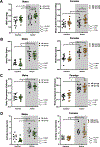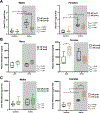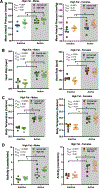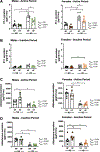Sex Differences in Diurnal Sodium Handling During Diet-Induced Obesity in Rats
- PMID: 35545941
- PMCID: PMC9186154
- DOI: 10.1161/HYPERTENSIONAHA.121.18690
Sex Differences in Diurnal Sodium Handling During Diet-Induced Obesity in Rats
Abstract
Background: Emerging evidence over the past several years suggests that diurnal control of sodium excretion is sex dependent and involves the renal endothelin system. Given recent awareness of disruptions of circadian function in obesity, we determined whether diet-induced obesity impairs renal handling of an acute salt load at different times of day and whether this varies by sex and is associated with renal endothelin dysfunction.
Methods: Male and female Sprague-Dawley rats were placed on a high-fat diet for 8 weeks before assessing renal sodium handling and blood pressure.
Results: Male, but not female, rats on high fat had a significantly reduced natriuretic response to acute NaCl injection at the beginning of their active period that was associated with lower endothelin 1 (ET-1) excretion, lower ET-1 mRNA expression in the cortex and outer medulla as well as lower ETB receptor expression in the outer medulla of the high-fat rats. Obese males also had significantly higher blood pressure (telemetry) that was exacerbated by adding high salt to the diet during the last 2 weeks. While female rats developed hypertension with a high-fat diet, they were not salt sensitive and ET-1 excretion was unchanged.
Conclusions: These data identify diet-induced obesity as a sex-specific disruptive factor for maintaining proper sodium handling. Although high-fat diets induce hypertension in both sexes, these data reveal that males are at greater risk of salt-dependent hypertension and further suggest that females have more redundant systems that can be productive against salt-sensitive hypertension in at least some circumstances.
Keywords: blood pressure; endothelin-1; kidney; obesity; sodium.
Figures





Similar articles
-
Endothelin mediates sex-differences in acclimation to high salt diet in rats.Biol Sex Differ. 2023 Oct 10;14(1):70. doi: 10.1186/s13293-023-00555-2. Biol Sex Differ. 2023. PMID: 37817272 Free PMC article.
-
Loss of endothelin B receptor function impairs sodium excretion in a time- and sex-dependent manner.Am J Physiol Renal Physiol. 2016 Nov 1;311(5):F991-F998. doi: 10.1152/ajprenal.00103.2016. Epub 2016 Aug 31. Am J Physiol Renal Physiol. 2016. PMID: 27582096 Free PMC article.
-
Low NaCl intake elevates renal medullary endothelin-1 and endothelin A (ETA) receptor mRNA but not the sensitivity of renal Na+ excretion to ETA receptor blockade in rats.Acta Physiol (Oxf). 2008 Mar;192(3):429-42. doi: 10.1111/j.1748-1716.2007.01751.x. Epub 2007 Sep 24. Acta Physiol (Oxf). 2008. PMID: 17892519
-
Acclimation to a High-Salt Diet Is Sex Dependent.J Am Heart Assoc. 2022 Mar;11(5):e020450. doi: 10.1161/JAHA.120.020450. Epub 2022 Feb 22. J Am Heart Assoc. 2022. PMID: 35191321 Free PMC article.
-
Sex differences in blood pressure regulation and hypertension: renal, hemodynamic, and hormonal mechanisms.Physiol Rev. 2024 Jan 1;104(1):199-251. doi: 10.1152/physrev.00041.2022. Epub 2023 Jul 21. Physiol Rev. 2024. PMID: 37477622 Free PMC article. Review.
Cited by
-
Mechanisms of sex and gender differences in hypertension.J Hum Hypertens. 2023 Aug;37(8):596-601. doi: 10.1038/s41371-023-00810-4. Epub 2023 Feb 16. J Hum Hypertens. 2023. PMID: 36797338 Review.
-
Current perspective on circadian function of the kidney.Am J Physiol Renal Physiol. 2024 Mar 1;326(3):F438-F459. doi: 10.1152/ajprenal.00247.2023. Epub 2023 Dec 22. Am J Physiol Renal Physiol. 2024. PMID: 38134232 Free PMC article. Review.
-
Mice lacking γENaC palmitoylation sites maintain benzamil-sensitive Na+ transport despite reduced channel activity.JCI Insight. 2023 Nov 8;8(21):e172051. doi: 10.1172/jci.insight.172051. JCI Insight. 2023. PMID: 37707951 Free PMC article.
-
Cross-Sex Hormone Therapy Is Associated With Loss of Circadian Rhythm in the Male Rat.Hypertension. 2025 Feb;82(2):241-254. doi: 10.1161/HYPERTENSIONAHA.124.23901. Epub 2024 Dec 5. Hypertension. 2025. PMID: 39633591
-
Salt sensitivity of blood pressure: mechanisms and sex-specific differences.Nat Rev Cardiol. 2025 Sep;22(9):611-628. doi: 10.1038/s41569-025-01135-0. Epub 2025 Feb 21. Nat Rev Cardiol. 2025. PMID: 39984695 Review.
References
-
- Tesfaye F, Nawi NG, Van Minh H, Byass P, Berhane Y, Bonita R, Wall S. Association between body mass index and blood pressure across three populations in africa and asia. J Hum Hypertens. 2007;21:28–37 - PubMed
-
- Hall JE, Granger JP, do Carmo JM, da Silva AA, Dubinion J, George E, Hamza S, Speed J, Hall ME. Hypertension: Physiology and pathophysiology. Compr Physiol. 2012;2:2393–2442 - PubMed
Publication types
MeSH terms
Substances
Grants and funding
LinkOut - more resources
Full Text Sources
Medical
Miscellaneous

